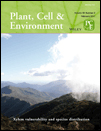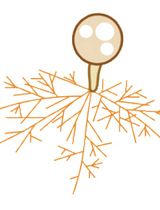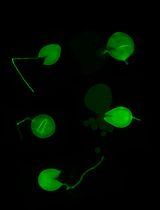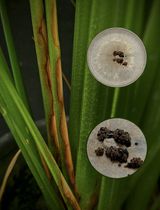- EN - English
- CN - 中文
A Method for Radioactive Labelling of Hebeloma cylindrosporum to Study Plant-fungus Interactions
一种用于研究植物-真菌相互作用的圆形孢子粘花菇放射性标记方法
发布: 2017年10月20日第7卷第20期 DOI: 10.21769/BioProtoc.2576 浏览次数: 7744
评审: Scott A M McAdamManjula MummadisettiAnonymous reviewer(s)
Abstract
In order to quantify P accumulation and P efflux in the ectomycorrhizal basidiomycete fungus Hebeloma cylindrosporum, we supplied 32P to mycelia previously grown in vitro in liquid medium. The culture had four main steps that are 1) growing the mycelium on complete medium with P, 2) transfer the mycelia into new culture solution with or without P, 3) adding a solution containing 32P and 4) rinsing the mycelia before incubation with or without plant. The main point is to rinse very carefully the mycelia after 32P supply in order to avoid overestimation of 32P efflux into the medium.
Keywords: Culture in vitro (体外培养)Background
It is well known that the association between mycorrhizal fungi and plants improves the P nutrition of the host-plant (reviewed by Smith and Read, 2008; Plassard and Dell, 2010; Cairney, 2011; Smith et al., 2015). This positive effect has been attributed primarily to phosphate (Pi) uptake by the fungal cells exploring the soil far from the roots, allowing the exploration of a large volume of soil beyond the depletion zone formed around actively absorbing roots (Smith and Read, 2008; Cairney, 2011; Smith et al., 2015). However, to benefit to the host plant, absorbed Pi has to be transported from the fungal cells exploring soil towards those in close contact with the host cells. In ectomycorrhizal symbiosis, these exchanges are thought to take place in a territory called the ‘Hartig net’ inside the ectomycorrhizal roots (Smith and Read, 2008; Cairney, 2011). In the Hartig net, the fungal cells colonize the walls of cortical cells but there is no direct communication between the two plasma membranes, meaning that P has to be released from the fungal cells via a yet unknown mechanism. Taken together, this knowledge indicates that the ability of the fungus to take up P in external hyphae and to release P is therefore an important feature of the fungal species for its positive effect on plant P nutrition. Here, we developed a methodology using 32P labelling to follow the net 32P accumulation and release by an ectomycorrhizal fungal species cultivable in vitro, without its host plant (Torres-Aquino et al., 2017). This method could be used with other fungal or plant material.
Materials and Reagents
- Sterile plastic Petri dish, 90 mm (Dominique DUTSCHER, Gosselin, catalog number: 688302 )
- Sterile plastic Petri dish, 35 mm (Corning, Falcon®, catalog number: 351008 )
- Liquid scintillation vial, 6 ml with cap (PerkinElmer, catalog number: 6000592 )
- Liquid scintillation vial, 20 ml with cap (PerkinElmer, catalog number: 6008117 )
- Waste bags for radionuclides (SCIE-PLAS, catalog number: RRP-BAG17 )
- Protective paper for bench (Dominique DUTSCHER, Benchguard, catalog number: 090277 )
- Liquid scintillation cocktail Ultimagold (PerkinElmer, catalog number: 6013329 )
- Nichrome wire, stainless steel, round, 22 gauge, 0.64 mm diameter (suppliers for electronic cigarettes)
- Aluminium screw cap, 40 mm with rubber liner (VWR, SPV, catalog number: 215-2690 )
- Multi-Purpose Silicone for kitchen or bathroom, 280 ml (Castorama, Rubson)
- 60 ml Luer-lock syringes (Dominique DUTSCHER, Omnifix, catalog number: 921016 )
- Teflon PTFE microtube, 1.15 mm and 1.75 mm for internal (int) and external (ext) diameter (diam), respectively (Dominique DUTSCHER, PTFE, catalog number: 091932 )
- Needles 18 G 0.9 x 40 mm (Dominique DUTSCHER, BD MicrolanceTM 3, catalog number: 301300 )
- Tubing, int diam 1.14 mm (Dominique DUTSCHER, Silicone, catalog number: 4906591 )
- Tubing, int diam 3.17 mm (Dominique DUTSCHER, Silicone, catalog number: 4906600 )
- Microtubes, 1.5 ml (Dominique DUTSCHER, Eppendorf, catalog number: 033511 )
- Valve Luer polycarbonate one way (Cole-Parmer, catalog number: EW-30600-01 )
- Sterile syringe filters for air, 0.2 µm, 6.4 cm diam (Labomoderne, Midisart, catalog number: RS3320 )
- Autoclavable Polypropylene bag, 3 L, non-printed (Dominique DUTSCHER, catalog number: 140230 )
- Tips 1,200 µl for pipet (Dominique DUTSCHER, Sartorius, catalog number: 077200B )
- Home-made syringe holder
- Home-made needle holder for aeration
- Folding skirted caps, 14.9 mm diam (Dominique DUTSCHER, catalog number: 110602 )
- Paper for sterilization (Dominique DUTSCHER, catalog number: 006950 )
- Hebeloma cylindrosporum (ectomycorrhizal basidiomycete) (laboratory’s own collection, available upon request)
- Manganese(II) sulfate monohydrate (MnSO4·H2O) (Sigma-Aldrich, catalog number: M7899-500G )
- Zinc sulfate heptahydrate (ZnSO4·7H2O) (Sigma-Aldrich, catalog number: Z0251-100G )
- Boric acid (H3BO3) (Sigma-Aldrich, catalog number: B6768-500G )
- Copper(II) sulfate pentahydrate (CuSO4·5H2O) (Sigma-Aldrich, catalog number: C8027-500G )
- Sodium molybdate dihydrate (Na2MoO4·2H2O) (Sigma-Aldrich, catalog number: M1651-100G )
- Potassium nitrate (KNO3) (Sigma-Aldrich, catalog number: P8291-1KG )
- Sodium phosphate monobasic monohydrate (NaH2PO4·H2O) (Sigma-Aldrich, catalog number: 71504-250G-M )
- Magnesium sulfate heptahydrate (MgSO4·7H2O) (Sigma-Aldrich, catalog number: 63138-250G )
- Potassium chloride (KCl) (Sigma-Aldrich, catalog number: P9333-500G )
- Calcium chloride dihydrate (CaCl2·2H2O) (Sigma-Aldrich, catalog number: C5080-500G )
- Ferric ammonium citrate (Sigma-Aldrich, catalog number: RES20400-A702X )
- D-glucose (Sigma-Aldrich, catalog number: G8270-1KG )
- Agar-agar (Sigma-Aldrich, catalog number: A7002-500G )
- KH232PO4 in water (PerkinElmer, catalog number: NEX055002MC )
- 2-N-morpholino-ethanesulfonic acid, 4-morpholineethanesulfonic acid monohydrate (MES) (Sigma-Aldrich, catalog number: 69892-500G )
- Tris(hydroxymethyl)aminomethane (TRIS) (Sigma-Aldrich, catalog number: T1378-500G )
- 1 N sulfuric acid solution (EMD Millipore, catalog number: 1.09072.1000 )
- Trace elements (see Recipes)
- Mineral salt base solutions (see Recipes)
- Thiamine solution (see Recipes)
- N6 complete liquid solution (see Recipes)
- Solid N6 complete liquid solution (see Recipes)
- Interaction medium (IM) (see Recipes)
Equipment
- Sample bottles,120 ml (VWR, SPV, catalog number: SPVAGO2246 )
- Glass bottles, 1,000 ml, ISO borosilicate, graduated (Dominique DUTSCHER, catalog number: 046415 )
- Glass bottles, 2,000 ml, ISO borosilicate, graduated (Dominique DUTSCHER, catalog number: 046416 )
- Two pairs of stainless steel straight tweezers Wironit, Brucelles type, 130 mm (Dominique DUTSCHER, catalog number: 491037 )
- A scalpel handle for blade 20 to 25 (Dominique DUTSCHER, catalog number: 3740004 )
- Surgical blade sterile N°21 (Dominique DUTSCHER, catalog number: 132521 )
- A standalone burner (Dominique DUTSCHER, catalog number: 071109 )
- Butane gas cartridge for the burner (Dominique DUTSCHER, catalog number: 060415 )
- A nail, a hammer, scissors and cutting pliers
- Incubator with controlled temperature set at 25 °C
- Autoclave
- Laminar flow cabinet
- Cork-borer, 7.5 mm diameter (Dominique DUTSCHER, catalog number: 942783 )
- Aquarium air-pumps (SuperFish, model: air-box Nr.4 )
- Shield, fixed 15° angle, flat base, Beta; 530 x 350 mm shield; 350 x 300 mm base (upright x horizontal) (SCIE-PLAS, catalog number: RPP-S15L )
- Midi-box with hinged lid, Beta; external dimensions: 80 x 185 x 105 mm; internal dimensions: 60 x 165 x 85 mm (height x width x depth) (SCIE-PLAS, catalog number: RPP-B6 )
- Bin for beta wastes on the bench, 3.3 L capacity (SCIE-PLAS, catalog number: RPP-B17 )
- Liquid scintillation Counter TRI-CARB 4910TR (PerkinElmer, catalog number: A491000 )
Software
- Microsoft Excel for calculations
- Statistica 7.1 (StatSoft Inc., Tulsa, OK, USA) for statistical analysis
Procedure
文章信息
版权信息
© 2017 The Authors; exclusive licensee Bio-protocol LLC.
如何引用
Becquer, A., Torres-Aquino, M., Le Guernevé, C., Amenc, L. K., Trives-Segura, C., Staunton, S., Quiquampoix, H. and Plassard, C. (2017). A Method for Radioactive Labelling of Hebeloma cylindrosporum to Study Plant-fungus Interactions. Bio-protocol 7(20): e2576. DOI: 10.21769/BioProtoc.2576.
分类
微生物学 > 微生物-宿主相互作用 > 真菌
细胞生物学 > 细胞分离和培养 > 共培养
您对这篇实验方法有问题吗?
在此处发布您的问题,我们将邀请本文作者来回答。同时,我们会将您的问题发布到Bio-protocol Exchange,以便寻求社区成员的帮助。
Share
Bluesky
X
Copy link













